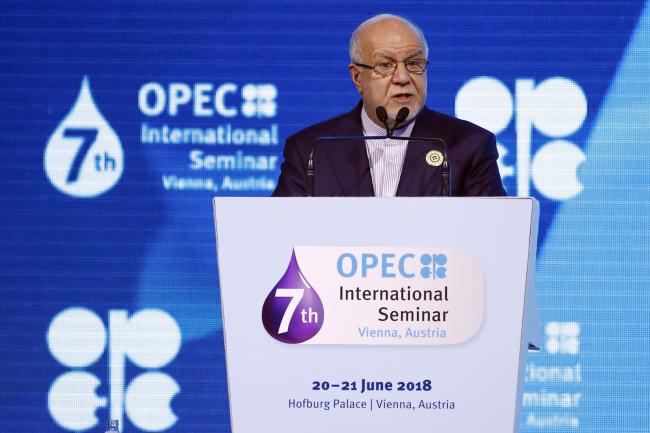(Bloomberg) -- The odds of OPEC reaching an oil-production deal increased as Iran edged away from a threat to veto any agreement that would raise output.
After sitting down with counterparts from several countries, Iranian Minister Bijan Namdar Zanganeh said he was optimistic about the outcome of the OPEC meeting, a marked contrast to comments the previous day when he said a deal was unlikely. Saudi Energy Minister Khalid Al-Falih said every minister he’s spoken to agrees that it’s time for the group to change course.
“I’m confident that at the end of the day reason will prevail,” Al-Falih told reporters in Vienna, after a succession of meetings with his counterparts from other major producers. He was echoing earlier comments from OPEC Secretary-General Mohammad Barkindo.
With two days until ministers from the Organization of Petroleum Exporting Countries formally meet in Vienna to decide on policy, delegates attempted to find a plan to boost production and ease consumer anxiety about high oil prices that wouldn’t provoke a veto. The talks, held as the cartel hosted an international energy conference attended by hundreds of officials, executives and investors, will shape oil prices, energy stocks and currencies of petroleum-exporting countries for months to come.
In the chandeliered halls of Vienna’s Hofburg palace on Wednesday, the oil ministers of Saudi Arabia and the U.A.E. held private bilateral meetings with other OPEC members in an effort to thrash out a compromise.
Production Collapse
Saudi Arabia, under pressure from U.S. President Donald Trump, wants to unwind some of the cuts by engineering a “moderate” supply boost in the second half of the year. Russia is pushing for an even larger quota increase of 1.5 million barrels a day, although the details of its proposal suggest a smaller volume of extra oil would actually flow into the market.
Iran, with some support from Venezuela, has so far rejected any increase, including one compromise mooted in private by some OPEC officials for a 300,000-to-600,000 barrel-a-day hike in the second half of the year.
There’s a good reason for the two countries’ opposition -- neither have the ability to increase their own production. Iran faces constraints on its oil exports after Trump reimposed sanctions on May 8. Venezuela’s oil industry is collapsing due to years of mismanagement and an economic crisis.
Excessive Cuts
One way to bridge the gap between Saudi Arabia and Iran could involve a carefully worded communique proposing that those group members that have cut deeper than intended should return to their original quotas.
When OPEC and its allies, which include Russia, Kazakhstan and Mexico, agreed to cut output in late 2016, they announced a 1.8 million-barrel-a-day reduction. But problems in Venezuela, Mexico and other nations mean the reduction in May was closer to 2.2 million.
“We’re not going to increase production, we’re going to decrease the cut,” said Oman’s Oil Minister Mohammed Al Rumhy, who represents non-OPEC nations on a committee that oversees the deal.
The net effect of Zanganeh’s proposal could be only a small increase in supply because the biggest extra cuts have come from countries that don’t have the ability to restore lost output. So the key element of any face-saving deal to reduce excessive cuts is whether Saudi Arabia can compensate for countries that won’t be able to pump more, such as Venezuela. If so, the deal could allow output to rise by nearly 400,000 barrels a day, based on data from the International Energy Agency.
Iran has so far said other countries shouldn’t be able to boost output even further to offset losses from other members.
Oil prices surged nearly 75 percent, touching $80 a barrel, after OPEC and allies agreed to cut production in late 2016. That surge prompted the U.S. president to complain on Twitter that the cartel was artificially inflating prices. Benchmark Brent crude has slipped back, trading near $75 on Wednesday, as the group responded by discussed easing their curbs.To read a Quick Take on OPEC’s recent history, click here.
Trump’s involvement makes it difficult for Tehran to accept a compromise. Zanganeh has said the president is to blame for high prices because of his unilateral withdrawal from the international nuclear agreement.
“OPEC is an independent organization, not an organization to receive instruction from President Trump,” Zanganeh said on Tuesday. “OPEC is not part of the Department of Energy of the United States.”
OPEC takes its decisions by unanimity, so if Iran were to wield its veto Saudi Arabia would be left only with the option of assembling a coalition of willing countries to bypass Tehran’s opposition. Riyadh could also act unilaterally boosting output, as it did in 2011 after a meeting ended in acrimony without a deal.
"OPEC is listening to consumers,” Bob Dudley, the chief executive of BP (LON:BP) Plc, said on the sidelines of the OPEC conference in Vienna. "They pay attention to consumer nations."
(Updates with Saudi minister’s comment in third paragraph.)
